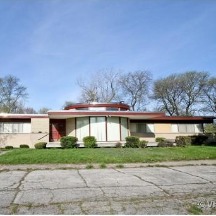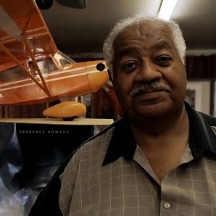Back in 1931, two years after the Great Depression had started, two men and two women joined forces to create the Robbins Airport, the nation’s first Black airport. They constructed the one strip airfield in the first Black town incorporated in the northern half of the United States and the sixth in the United States, Robbins, Illinois. Today, the Robbins Illinois History Museum wants to renovate the home of SB Fuller, one of the nation’s first Black millionaires, for its new museum in the same historic village, Robbins.
“Mr. Fuller himself is worthy of having his legacy preserved and his home is five times larger than our current space,” explained Tyrone Haymore, historian/curator of the Robbins History Museum. Haymore has lived in Robbins for 71 years.
John C. Robinson, Cornelius R. Coffey, Janet Bragg, and Willa Brown were the airport developers. Ironically, both men were born the same year that aviation was born, in 1903. Both were reared and schooled in Mississippi and Arkansas. Both men met in Detroit as auto-mechanics and decided, following Bessie Coleman's death, to enroll in the segregated Curtiss-Wright Aeronautical School in Chicago, owned by Glenn Curtiss and the Wright Brothers, Orville and Wilbur. (Coleman was the first African-American woman to hold a pilot license.) Robinson and Coffey became the first African Americans to graduate from this school as aviation pilots and mechanics, and started their own aviation school in Robbins.
Because of his work and influence in aviation, he is often considered the "Father of the Tuskegee Airmen” and the “Father of Ethiopian Airlines.”
In April 1935, when Italy attacked the homeland, Ethiopian Emperor Haile Selassie wired an official invitation to Robinson offering him an officer's commission in the fledging Ethiopian air force. Robinson accepted and was later named the commander of the Air Force and played a role in the foundation of Ethiopian Airlines. Because of his work and influence in aviation, he is often considered the "Father of the Tuskegee Airmen” and the “Father of Ethiopian Airlines.”
Coffey invented the first carburetor heater for airplanes which allowed planes to fly more safely in the winter by keeping the fuel line from freezing and pilots memorialize him today when flying to Chicago’s Midway Airport and they make a course correction over Lake Calumet. They call the maneuver the Coffey Fix. Coffey was the only one of the four Robbins Airport founders that Haymore knew. “I knew him during the last eight years of his life. He died at the age of 92 from pneumonia after working on his plane in the rain,” Haymore recalls.
Willa Brown, once a school teacher in the nearby Gary Public School system, became the first Black woman to earn a US pilot license in 1939. Janet Bragg provided $600 of her own money to buy the school's first airplane and help build the school's airfield, and she became the first African-American women to earn a commercial pilot license in 1943.
The quartet founded the airport because of northern segregation practices. It lasted only two years until a storm destroyed it. Instead of rebuilding it, they took the offer to move their operations and training school to the 87 Street and Harlem Airport in the southwest suburban Chicago village of Bridgeview. During its short life, the airport created its own legacy including being the site where ten of the original Tuskegee Airmen learned to fly.
The village of Robbins was incorporated in 1917 and named for Henry E. Robbins, a real estate developer who laid out the village's early subdivisions. The village, as small towns are called in Illinois, “was a place for recently arrived southern Blacks who wanted to maintain a rural lifestyle, but be close enough to the jobs in Chicago,” added Haymore.
Robbins, Illinois Seeks to Convert Early Black Millionaire Home into Museum
Features




At its population peak in the 1970s, the town was home to about 10,000 people. Today, about 5,000 people make their home in the village which is about 30 minutes from downtown Chicago to the northeast and Gary, Indiana to the east.
One of Robbins' most famous residents, S.B. Fuller, was born in Louisiana in 1905. Like so many Blacks, he migrated during the Great Black Migration to Memphis, later to Metro Chicago, and eventually he made Robbins his home. He bought a cottage there and later built a mansion in 1958 on the same site. The museum now owns the mansion, but needs assistance to upgrade and preserve the building. “The house had six bathrooms, but much has been stolen and vandalized.”
A gracious donor provided the Robbins' museum the Fuller mansion, but the building is badly in need of a new roof and interior improvements.
At age nine in Louisiana, the future millionaire, sold products door-to-door and gained on the street entrepreneurial experience. By 1939, he opened his own factory. In 1947, the year Jackie Robison signed with the Brooklyn Dodgers, Fuller purchased the company that once employed him, Boyer International Laboratories, to prevent its bankruptcy. They made and sold Jean Nadal Cosmetics. The company`s clientele was predominantly White and in the South. He kept his ownership a secret.
The company began to manufacture and sell a diverse line of commodities from deodorant and hair care to hosiery and men's suits. Fuller also purchased several newspapers including the New York Age and the Pittsburgh Courier. Additionally, he owned the South Center Department Store and the Regal Theater in Chicago.
During the 1950s, Fuller, with a sixth-grade education, was probably the richest African American man in the United States. His cosmetics company had $18 million in sales and a sales force of five thousand (one-third of them White).
A gracious donor provided the Robbins' museum the Fuller mansion, but the building is badly in need of a new roof and interior improvements. “The House was built with six bathrooms and even though vandals have taken or destroyed most of the fixtures, we need to transform the entire interior to make the home into a museum and be able to display artifacts that we have had in storage for years,” added Haymore.
To raise money to preserve the village’s oversized contribution to history, Haymore has hired grant writers who have raised small amounts and he continues to talk with several potential supporters. “We plan to acknowledge donors with a name plaque on a special wall within the house,” he says with the hope for a donation.
See Also:
The 21st Annual Calumet Heritage Conference
GoFundMe Campaign
POH Podcast with Tyrone Haymore on historic Robbins, IL
One of Robbins' most famous residents, S.B. Fuller, was born in Louisiana in 1905. Like so many Blacks, he migrated during the Great Black Migration to Memphis, later to Metro Chicago, and eventually he made Robbins his home. He bought a cottage there and later built a mansion in 1958 on the same site. The museum now owns the mansion, but needs assistance to upgrade and preserve the building. “The house had six bathrooms, but much has been stolen and vandalized.”
A gracious donor provided the Robbins' museum the Fuller mansion, but the building is badly in need of a new roof and interior improvements.
At age nine in Louisiana, the future millionaire, sold products door-to-door and gained on the street entrepreneurial experience. By 1939, he opened his own factory. In 1947, the year Jackie Robison signed with the Brooklyn Dodgers, Fuller purchased the company that once employed him, Boyer International Laboratories, to prevent its bankruptcy. They made and sold Jean Nadal Cosmetics. The company`s clientele was predominantly White and in the South. He kept his ownership a secret.
The company began to manufacture and sell a diverse line of commodities from deodorant and hair care to hosiery and men's suits. Fuller also purchased several newspapers including the New York Age and the Pittsburgh Courier. Additionally, he owned the South Center Department Store and the Regal Theater in Chicago.
During the 1950s, Fuller, with a sixth-grade education, was probably the richest African American man in the United States. His cosmetics company had $18 million in sales and a sales force of five thousand (one-third of them White).
A gracious donor provided the Robbins' museum the Fuller mansion, but the building is badly in need of a new roof and interior improvements. “The House was built with six bathrooms and even though vandals have taken or destroyed most of the fixtures, we need to transform the entire interior to make the home into a museum and be able to display artifacts that we have had in storage for years,” added Haymore.
To raise money to preserve the village’s oversized contribution to history, Haymore has hired grant writers who have raised small amounts and he continues to talk with several potential supporters. “We plan to acknowledge donors with a name plaque on a special wall within the house,” he says with the hope for a donation.
See Also:
The 21st Annual Calumet Heritage Conference
GoFundMe Campaign
POH Podcast with Tyrone Haymore on historic Robbins, IL
Advertisers | Contact Us | Events | Links | Media Kit | Our Company | Payments Pier
Press Room | Print Cover Stories Archives | Electronic Issues and Talk Radio Archives | Writer's Guidelines






